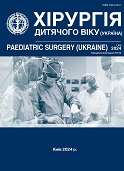Study of relative deformations of interfragmentary regenerate in models of different osteosynthesis options of tibia bones with fractures in the middle third in children with osteogenesis imperfecta and incomplete growth
DOI:
https://doi.org/10.15574/PS.2024.82.50Keywords:
osteogenesis imperfecta, tibia, fracture, osteosynthesisAbstract
Introduction. Osteogenesis imperfecta is a genetic pathology that leads to a violation of the processes of formation of collagen fibers, formation of bone matrix and its mineralization and, as a result, to the formation of bone tissue with low strength properties. The most promising means of stabilizing bone fragments under this condition are intramedullary fixators of various designs.
Aim. To investigate the relative deformations of the interfragmentary regenerate under the influence of various types of loads in models of the tibia with fractures of both bones in the middle third and their osteosynthesis using intramedullary rods of various designs in children with osteogenesis imperfecta and incomplete growth.
Materials and methods. Mathematical modeling of options for osteosynthesis of tibia bones with a fracture in the middle third in children with osteogenesis imperfecta was performed. Two variants for tibial osteosynthesis were modelled: a rod without rotational stability; rod with rotational stability. Osteosynthesis of the fibula was not modelled in all variants. The stress-strain state of the model under the influence of vertical compressive, bending and torsional loads, as well as the magnitude of the relative deformations of the interstitial regenerate, were studied.
The results. A “growing” intramedullary shear with rotational stability provides essential advantages in the case of torsional loads. The presence of rotational stability makes it possible to ensure two times lower values of relative deformations of interfragmentary regenerates compared to osteosynthesis with a rotationally unstable rod. Under compressive and bending loads, both rods showed almost identical results of relative deformations of bone regenerates. High rates of deformation of interfragmentary tibial regenerates are due to the lack of longitudinal axial stability of both rods, which is the basis for the possibility of increasing their length during the growth of the patient.
Conclusions. The use of osteosynthesis with intramedullary rods, which increase during the treatment of tibial fractures in patients with osteogenesis imperfecta, does not ensure a sufficient level of stability for the fixation of bone fragments under compression and bending loads, which leads to the greatest deformations of bone regenerates. A rod with rotational stability provides advantages in resistance to torsional loads, which is determined by twice lower relative deformations of interfragmentary regenerates.
No conflict of interests was declared by the authors.
References
Boccaccio A, Pappalettere C. (2011). Mechanobiology of Fracture Healing: Basic Principles and Applications in Orthodontics and Orthopaedics. Theoretical Biomechanics. Dr Vaclav Klika (Ed.). https://doi.org/10.5772/19420
Cowin SC. (2001). Bone mechanics. Handbook. Edited by Stephen C. Cowin. CRC Press Reference. https://doi.org/10.1201/b14263; PMCid:PMC2190562
El-Adl G, Khalil MA, Enan A, Mostafa MF, El-Lakkany MR. (2009). Telescoping versus non-telescoping rods in the treatment of osteogenesis imperfecta. Acta Orthopædica Belgica. 75(2): 200.
Jepsen KJ, Goldstein SA, Kuhn JL, Schaffler MB, Bonadio J. (1996). Type‐I collagen mutation compromises the post‐yield behavior of Mov13 long bone. Journal of orthopaedic research. 14(3): 493-499. https://doi.org/10.1002/jor.1100140320; PMid:8676263
Khmyzov SO, Katsalap YeS, Karpinsky MJu, Karpinska O. (2022). Experimental study of bone density in patients with congenital pseudoarthrosis of the tibia before and after surgery. Wiadomości Lekarskie. LXXV (9); part 1: 2112-2120. https://doi.org/10.36740/WLek202209112; PMid:36256938
Khmyzov SO, Katsalap YeS, Karpinsky MYu, Karpinska OD. (2022). Experimental study of bone tissue density in patients with congenital pseudarthrosis of the tibia bones before and after surgery according to computer tomography data. Paediatric Surgery (Ukraine). 3(76): 59-67. https://doi.org/10.15574/PS.2022.76.59
Khmyzov SO, Katsalap YeS, Karpinsʹkyy MYu, Yaresʹko OV. (2022). Doslidzhennya deformatsiy kistkovoho reheneratu za riznykh variantiv osteosyntezu kistok homilky v razi yikhnʹoho urodzhenoho psevdoartrozu. Ortopedyya, travmatolohyya y protezyrovanye. (1-2): 49-54. https://doi.org/10.15674/0030-598720221-249-54
Khmyzov SO, Pashenko AV, Kovalʹov AM. (2016). Prystriy dlya khirurhichnoho likuvannya deformatsiy stehnovykh kistok u ditey z nezavershenym rostom. Patent na korysnu modelʹ UA No.114597U, A61V17/72. Patentovlasnyk DU "Instytut patolohiyi khrebta ta suhlobiv imeni profesora M.I. Sytenka NAMN Ukrayiny". Zayavka u201610052 vid 03.10.2016. Opubl. 10.03.2017. Byul. No.5.
Kumar K, Zindani D, Davim JP. (2020). Mastering SolidWorks. Practical Examples. Springer Cham: 316. https://doi.org/10.1007/978-3-030-38901-7
Lehmann HW, Herbold M, Von Bodman J, Karbowski A, Stücker R. (2000). Osteogenesis imperfecta Aktuelles Therapiekonzept. Monatsschrift Kinderheilkunde. 148(11): 1024-1029. https://doi.org/10.1007/s001120050687
Niinomi M. (2008). Mechanical biocompatibilities of titanium alloys for biomedical applications. J Mech Behav Biomed Mater. 1(1): 30-42. https://doi.org/10.1016/j.jmbbm.2007.07.001; PMid:19627769
Rao SS. (2010). The Finite Element Method in Engineering: Fifth Edition. Editeur: Elsevier Science. Année de Publication: 726. ISBN: 978-1-85617-661-3.
Sillence DO, Senn A, Danks DM. (1979). Genetic heterogeneity in osteogenesis imperfecta. Journal of Medical Genetics. 16(2): 101-116. https://doi.org/10.1136/jmg.16.2.101; PMid:458828 PMCid:PMC1012733
Sillence D, Danks D. (1978). Differentiation of genetically distinct varieties of osteogenesis imperfecta in newborn period. In Clinical Research. 26(2): A178-A178.
Vidal-Lesso A, Ledesma-Orozco E, Daza-Benítez L, Lesso-Arroyo R. (2014). Mechanical Characterization of Femoral Cartilage Under Unicompartimental Osteoarthritis. Ingeniería Mecánica Tecnología Y Desarrollo. 4 (6): 239-246.
Downloads
Published
Issue
Section
License
Copyright (c) 2024 Paediatric Surgery (Ukraine)

This work is licensed under a Creative Commons Attribution-NonCommercial 4.0 International License.
The policy of the Journal “PAEDIATRIC SURGERY. UKRAINE” is compatible with the vast majority of funders' of open access and self-archiving policies. The journal provides immediate open access route being convinced that everyone – not only scientists - can benefit from research results, and publishes articles exclusively under open access distribution, with a Creative Commons Attribution-Noncommercial 4.0 international license(СС BY-NC).
Authors transfer the copyright to the Journal “PAEDIATRIC SURGERY.UKRAINE” when the manuscript is accepted for publication. Authors declare that this manuscript has not been published nor is under simultaneous consideration for publication elsewhere. After publication, the articles become freely available on-line to the public.
Readers have the right to use, distribute, and reproduce articles in any medium, provided the articles and the journal are properly cited.
The use of published materials for commercial purposes is strongly prohibited.

